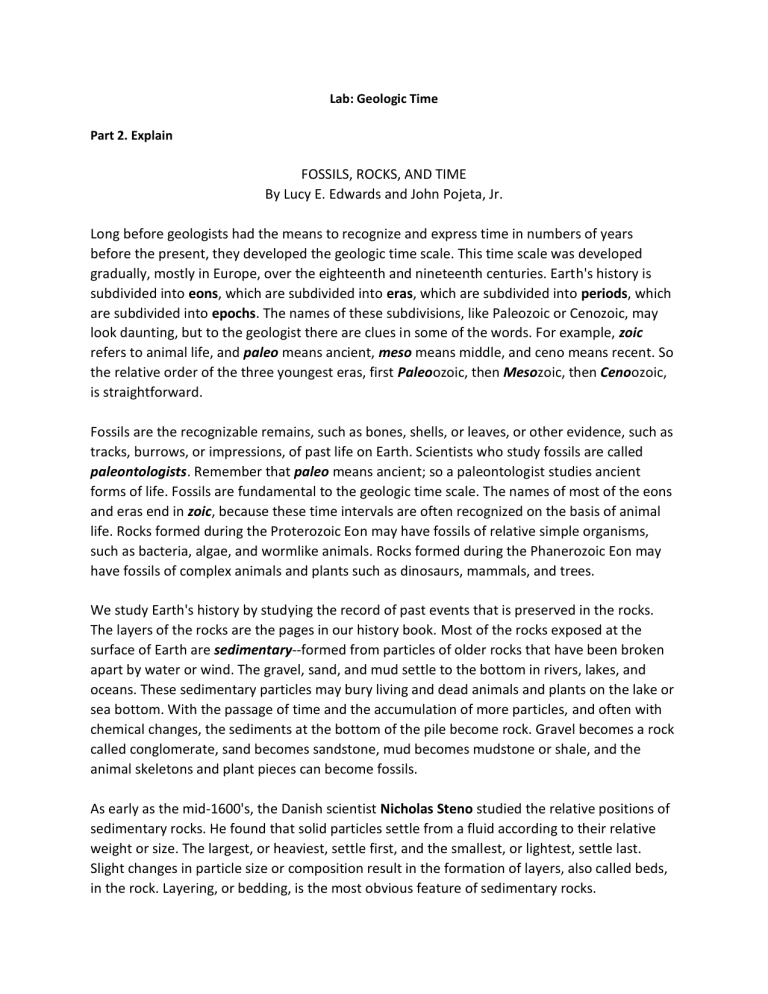
Lab: Geologic Time Part 2. Explain FOSSILS, ROCKS, AND TIME By Lucy E. Edwards and John Pojeta, Jr. Long before geologists had the means to recognize and express time in numbers of years before the present, they developed the geologic time scale. This time scale was developed gradually, mostly in Europe, over the eighteenth and nineteenth centuries. Earth's history is subdivided into eons, which are subdivided into eras, which are subdivided into periods, which are subdivided into epochs. The names of these subdivisions, like Paleozoic or Cenozoic, may look daunting, but to the geologist there are clues in some of the words. For example, zoic refers to animal life, and paleo means ancient, meso means middle, and ceno means recent. So the relative order of the three youngest eras, first Paleoozoic, then Mesozoic, then Cenoozoic, is straightforward. Fossils are the recognizable remains, such as bones, shells, or leaves, or other evidence, such as tracks, burrows, or impressions, of past life on Earth. Scientists who study fossils are called paleontologists. Remember that paleo means ancient; so a paleontologist studies ancient forms of life. Fossils are fundamental to the geologic time scale. The names of most of the eons and eras end in zoic, because these time intervals are often recognized on the basis of animal life. Rocks formed during the Proterozoic Eon may have fossils of relative simple organisms, such as bacteria, algae, and wormlike animals. Rocks formed during the Phanerozoic Eon may have fossils of complex animals and plants such as dinosaurs, mammals, and trees. We study Earth's history by studying the record of past events that is preserved in the rocks. The layers of the rocks are the pages in our history book. Most of the rocks exposed at the surface of Earth are sedimentary--formed from particles of older rocks that have been broken apart by water or wind. The gravel, sand, and mud settle to the bottom in rivers, lakes, and oceans. These sedimentary particles may bury living and dead animals and plants on the lake or sea bottom. With the passage of time and the accumulation of more particles, and often with chemical changes, the sediments at the bottom of the pile become rock. Gravel becomes a rock called conglomerate, sand becomes sandstone, mud becomes mudstone or shale, and the animal skeletons and plant pieces can become fossils. As early as the mid-1600's, the Danish scientist Nicholas Steno studied the relative positions of sedimentary rocks. He found that solid particles settle from a fluid according to their relative weight or size. The largest, or heaviest, settle first, and the smallest, or lightest, settle last. Slight changes in particle size or composition result in the formation of layers, also called beds, in the rock. Layering, or bedding, is the most obvious feature of sedimentary rocks. Sedimentary rocks are formed particle by particle and bed by bed, and the layers are piled one on top of the other. Thus, in any sequence of layered rocks, a given bed must be older than any bed on top of it. This Law of Superposition is fundamental to the interpretation of Earth history, because at any one location it indicates the relative ages of rock layers and the fossils in them. Layered rocks form when particles settle from water or air. Steno's Law of Original Horizontality states that most sediments, when originally formed, were laid down horizontally. However, many layered rocks are no longer horizontal. Because of the Law of Original Horizontality, we know that sedimentary rocks that are not horizontal either were formed in special ways or, more often, were moved from their horizontal position by later events, such as tilting during episodes of mountain building. Rock layers are also called strata (the plural form of the Latin word stratum), and stratigraphy is the science of strata. Stratigraphy deals with all the characteristics of layered rocks; it includes the study of how these rocks relate to time. To tell the age of most layered rocks, scientists study the fossils these rocks contain. Fossils provide important evidence to help determine what happened in Earth history and when it happened. The word fossil makes many people think of dinosaurs. Dinosaurs are now featured in books, movies, and television programs, and the bones of some large dinosaurs are on display in many museums. These reptiles were dominant animals on Earth for well over 100 million years from the Late Triassic through the Late Cretaceous. Many dinosaurs were quite small, but by the middle of the Mesozoic Period, some species weighed as much as 80 tons. By around 65 million years ago all dinosaurs were extinct. The reasons for and the rapidity of their extinction are a matter of intense debate among scientists. Editor's note: Many paleontologists consider birds to be surviving members of the theropod dinosaur lineage. Thus, it is correct to say "non-avian dinosaurs" here, rather than "dinosaurs." More information is available at http://www.ucmp.berkeley.edu/diapsids/dinosaur.html. March 25, 2010 In spite of all of the interest in dinosaurs, they form only a small fraction of the millions of species that live and have lived on Earth. The great bulk of the fossil record is dominated by fossils of animals with shells and microscopic remains of plants and animals, and these remains are widespread in sedimentary rocks. It is these fossils that are studied by most paleontologists. In the late eighteenth and early nineteenth centuries, the English geologist and engineer William Smith and the French paleontologists Georges Cuvier and Alexandre Brongniart discovered that rocks of the same age may contain the same fossils even when the rocks are separated by long distances. They published the first geologic maps of large areas on which rocks containing similar fossils were shown. By careful observation of the rocks and their fossils, these men and other geologists were able to recognize rocks of the same age on opposite sides of the English Channel. William Smith was able to apply his knowledge of fossils in a very practical way. He was an engineer building canals in England, which has lots of vegetation and few surface exposures of rock. He needed to know what rocks he could expect to find on the hills through which he had to build a canal. Often he could tell what kind of rock was likely to be below the surface by examining the fossils that had eroded from the rocks of the hillside or by digging a small hole to find fossils. Knowing what rocks to expect allowed Smith to estimate costs and determine what tools were needed for the job. Smith and others knew that the succession of life forms preserved as fossils is useful for understanding how and when the rocks formed. Only later did scientists develop a theory to explain that succession. Three concepts are important in the study and use of fossils: (1) Fossils represent the remains of once-living organisms. (2) Most fossils are the remains of extinct organisms; that is, they belong to species that are no longer living anywhere on Earth. (3) The kinds of fossils found in rocks of different ages differ because life on Earth has changed through time. If we begin at the present and examine older and older layers of rock, we will come to a level where no fossils of humans are present. If we continue backwards in time, we will successively come to levels where no fossils of flowering plants are present, no birds, no mammals, no reptiles, no four-footed vertebrates, no land plants, no fishes, no shells, and no animals. The three concepts are summarized in the general principle called the Law of Fossil Succession: The kinds of animals and plants found as fossils change through time. When we find the same kinds of fossils in rocks from different places, we know that the rocks are the same age. How do scientists explain the changes in life forms, which are obvious in the record of fossils in rocks? Early explanations were built around the idea of successive natural disasters or catastrophes that periodically destroyed life. After each catastrophe, life began anew. In the mid-nineteenth century, both Charles Darwin and Alfred Wallace proposed that older species of life give rise to younger ones. According to Darwin, this change or evolution is caused by four processes: variation, over-reproduction, competition, and survival of those best adapted to the environment in which they live. Darwin's theory accounts for all of the diversity of life, both living and fossil. His explanation gave scientific meaning to the observed succession of onceliving species seen as fossils in the record of Earth's history preserved in the rocks. Scientific theories are continually being corrected and improved, because theory must always account for known facts and observations. Therefore, as new knowledge is gained, a theory may change. Application of theory allows us to develop new plants that resist disease, to transplant kidneys, to find oil, and to establish the age of our Earth. Darwin's theory of evolution has been refined and modified continuously as new information has accumulated. All of the new information has supported Darwin's basic concept--that living beings have changed through time and older species are ancestors of younger ones. The Law of Fossil Succession is very important to geologists who need to know the ages of the rocks they are studying. The fossils present in a rock exposure or in a core hole can be used to determine the ages of rocks very precisely. Detailed studies of many rocks from many places reveal that some fossils have a short, well-known time of existence. These useful fossils are called index fossils. Today the animals and plants that live in the ocean are very different from those that live on land, and the animals and plants that live in one part of the ocean or on one part of the land are very different from those in other parts. Similarly, fossil animals and plants from different environments are different. It becomes a challenge to recognize rocks of the same age when one rock was deposited on land and another was deposited in the deep ocean. Scientists must study the fossils from a variety of environments to build a complete picture of the animals and plants that were living at a particular time in the past. The study of fossils and the rocks that contain them occurs both out of doors and in the laboratory. The field work can take place anywhere in the world. In the laboratory, rock saws, dental drills, pneumatic chisels, inorganic and organic acids, and other mechanical and chemical procedures may be used to prepare samples for study. Preparation may take days, weeks, or months--large dinosaurs may take years to prepare. Once the fossils are freed from the rock, they can be studied and interpreted. In addition, the rock itself provides much useful information about the environment in which it and the fossils were formed. The study of layered rocks and the fossils they contain is called biostratigraphy; the prefix bio is Greek and means life. This page is URL: http://pubs.usgs.gov/gip/fossils/reading.html Last updated 14 August 1997 (krw)



